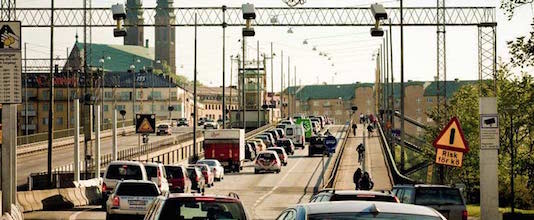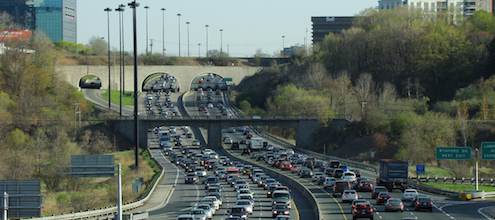
Think before you toll
On November 2nd, we released our congestion pricing report We Can’t Get There from Here: Why Pricing Congestion is Critical to Beating It. Guest blogger Jean-François Barsoum, Senior Managing Consultant, Smarter Cities, Water and Transportation, Innovation, Research & Development at IBM, gives us his opinion on congestion charging.
by Jean-François Barsoum
Implementing congestion charging is not rocket science: successful schemes have these three things in common
Whenever the topic of urban tolling pops up in the media, one might be forgiven for believing they’ve woken up in a real-world version of the film Groundhog Day. Are London and Stockholm appropriate models or exceptional cases that cannot be replicated? Isn’t a gas tax cheaper to administer? Aren’t we already paying taxes to build the roads? I’ve often listened to (and many times participated in) that debate over the past few years.
I thought it was time to take a fresh look at the successful examples of congestion charging and find out what we could learn from them… and I picked out some valuable lessons, but perhaps not the ones you might expect.
Lesson 1: Be clear about your destination
Successful congestion charging projects have, to a varying degree but inevitably, this one characteristic: a clear objective. The central London scheme wanted to reduce the number of vehicles in the downtown core to speed up travel times and increase predictability for deliveries; Greater London’s Low Emission Zone is meant to reduce smog; Stockholm’s congestion charging wants to reduce GHG emissions while decreasing bridge congestion at peak times. VMT (Vehicle-Miles-Travelled) projects, in Eindhoven or Oregon, are meant to drive broader behavioural changes – and in Oregon’s case, eventually become a major source of infrastructure funding. Clarity in the objectives will drive the design of the congestion charge: the zones covered, the technology used, the rates applied, and how success is measured. Without these measures of success, debates on effectiveness can continue to rage for years on end.
There is another reason for clarity of purpose: it drives the way the funds are spent. That point is not trivial: transparency in the use of congestion charging revenues is paramount to achieving social acceptance. In Stockholm, the government’s initial plan of spending the revenues on public transportation gave way to a more pragmatic practice, where funds are also used for road maintenance and construction.
Lesson 2: Don’t be a sucker for punishment
One of the most common criticisms I’ve seen of tolling is that it’s too “punitive”, and that we should positively encourage better behaviour. Some view this argument as pure hogwash, since pricing signals are so thoroughly embedded in all transportation choices that it is almost impossible to pull them all apart and know what the actual “true” costs are (roads are mostly paid by public funds, but gas is taxed; licensing fees are typically fixed but drivers’ license fees tend to increase based on bad driving records; and so on).
I have a more generous opinion – perhaps we should make a better place for positive reinforcement. Eindhoven, in its VMT pilot project, provided incentives to drivers who changed their habits: prizes for those who made major strides in reducing their rush-hour driving, including baskets of goodies and even champagne. There was a pricing scheme that was very progressive (rates at rush hour were more than double rates charged off peak, and urban residential streets were more expensive to drive on than rural roads). The result of the mixed approach was a resounding success – a 70% change in driving habits… the carrots softened the perceived impact of the sticks, and that is keeping with many others who have looked at this issue.
Lesson 3: Think outside the car
Whatever your final objective for congestion charging might be, the discussion is often limited to cars, when in fact the core issue is one of personal mobility: we don’t care if cars arrive at their destination faster; we care if people do. That distinction is important because the solutions to one-person-per-car rush hour are varied: carpooling, public transit, but also flexible work hours and working from home (or satellite office) options. These alternatives are important to alleviate congestion, but are critical when your implement congesting charging.
Why? Well, first of call, if drivers have no choice but to keep their existing habits, congestion will not improve. In fact, many critics of congestion charging state that providing more public transportation is a replacement for congestion charging; I believe that more public transportation is a necessary condition to achieving effective congestion charging.
More importantly, congestion charging gains legitimacy when there are options available to the driver and they feel they can change their transportation choices; and legitimacy is the greatest possible asset when a difficult political decision is made. Congestion charging is definitely one of those difficult political decisions.
Decisions, decisions
Of course, following these three lessons might not guarantee a traffic free future for any city. There are technology mistakes to avoid and communication plans need to be drawn and executed impeccably well.
Crucially, however, it’s important to have bold political leadership (or perhaps, the right political context) to start the process; in every case where successful congestion charging schemes have been tried – Stockholm, London, Singapore, Eindhoven, etc. – this has been the case. And that is perhaps one of the most elusive ingredients to any recipe.
About the Author
Jean-François Barsoum is the Senior Managing Consultant, Smarter Cities, Water and Transportation, Innovation, Research & Development at IBM. After joining IBM’s Strategy Consulting practice in 1996, Jean-François Barsoum began developing technology business plans and strategies. In 2008, he was among the few Canadians selected by the Al gore’s Climate Project to receive training from the Nobel peace laureate. In 2011, he joined the board of directors of Mr. Gore’s “Climate Reality Project Canada”. Throughout the years, he was a keynote speaker around the world on the topics of smart cities, innovation, corporate responsibility and climate change. He is a member of the steering committee of the David Suzuki Foundation (Québec), a director at the Canadian Water Network and the leader of IBM’s Green Community, founded in 1999.




Comments are closed.